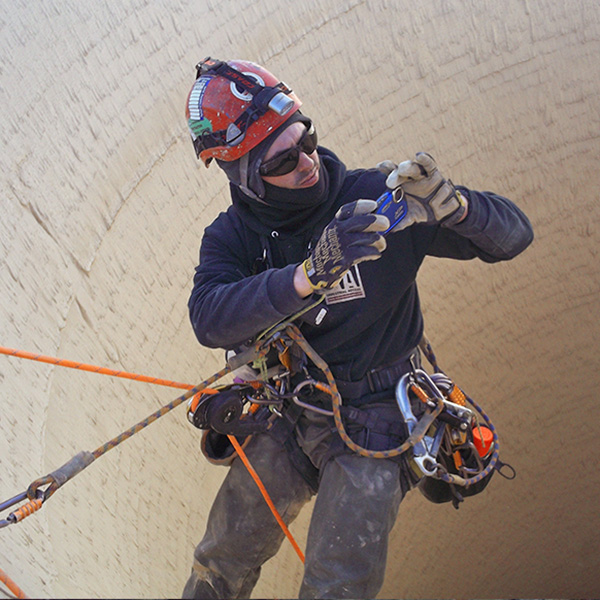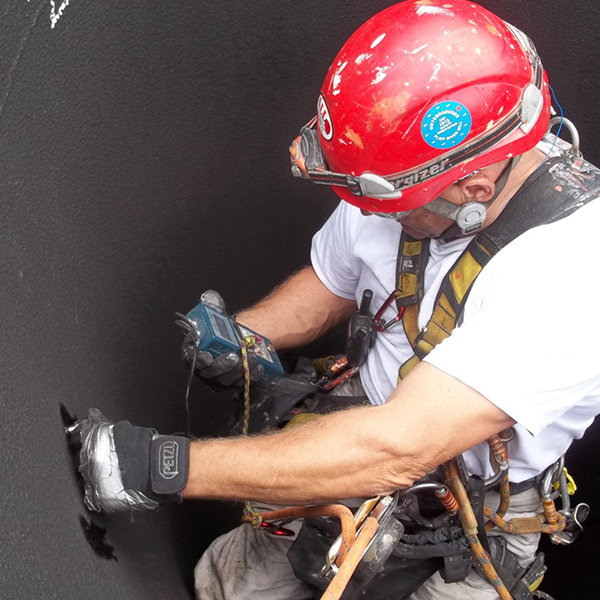Over the course of a few years, industrial chimneys and smokestacks are vulnerable to deterioration. Wind loading, temperature excursions, chemical attacks, and even lightning strikes and environmental factors can take their toll on an industrial chimney. Periodic industrial chimney inspections are crucial to quickly identifying and correcting early signs of deterioration and wear & tear. When caught early enough, these vulnerabilities can be fixed before they require expensive and time-consuming repairs or become a danger to the health and safety of employees and neighbors.
 Because the most vulnerable areas on an industrial chimney are hard to see from ground level, rope access becomes a viable solution that will save both time and money for inspection and testing services. As part of a sound, periodic inspection and maintenance program, a qualified rope access chimney expert can be a key partner for keeping your chimney or smokestack in good working order.
Because the most vulnerable areas on an industrial chimney are hard to see from ground level, rope access becomes a viable solution that will save both time and money for inspection and testing services. As part of a sound, periodic inspection and maintenance program, a qualified rope access chimney expert can be a key partner for keeping your chimney or smokestack in good working order.
Our rope access technicians often get asked about the inspection process. Facility managers may wonder what an inspection entails. Here is an in-depth guide to the types and methods of industrial chimney inspection and testing services:
Classes of Inspections
The first step in any inspection service is visual analysis to determine the condition of the structure and the extent of any maintenance needed. By using binoculars from ground level, a technician can identify any major vulnerabilities. For a closer look at the surface of the structure, rope access technicians will also perform a visual inspection ladders, platforms, or access points that offer a good view of the structure. This exterior inspection is considered a Class I Inspection and should be done yearly to help identify potential problems that may be developing.
When an industrial chimney or stack requires a close-up physical inspection of both the exterior and interior, a Class II Inspection is performed. Class II Inspections are performed with the stack off-line so that rope access technicians can descend down both the interior and exterior of the stack, looking for cracks, deterioration, breaches, leaks, water damage, etc. Rigging is installed at the top of the chimney or stack and special equipment is used to allow a team of technicians to scale down the side of the structure. Notes and photographers are taken at fixed intervals to record abnormalities, damage, or safety hazards. The technicians then complete a full inspection report that identifies urgent concerns and suggested repairs or maintenance plans.
Class III Inspections are performed after unique circumstances such as natural disasters, explosions, overheating, or other dangerous occurrences. This level of inspection requires an intensive examination of the structure for safety and stability. A Class III Inspection includes all of the tasks in a Class II Inspection PLUS physical sampling, testing and engineering review. A Class III Inspection will also be performed before the installation of major components like a new lining system.
Nondestructive Testing
Non Destructive Testing (NDT) methods are often used to provide information on the structural integrity of an industrial chimney or smokestack. The goal of NDT is to examine structures in a manner that does not affect the usefulness or performance of the material. No physical samples are taken which can increase the vulnerability of the structure and construction materials. NDT allows testing and measurement of physical characteristics such as the thickness of steel or fiber reinforced plastic (FRP) or the hardness of concrete without damage to the structure.

Some types of nondestructive tests include:
- Ultrasonic Thickness testing (UT) – UT is used to identify the relative thickness of the material at various coordinates, to detect any areas of wear and thinning that may pose a danger of collapse.
- Schmidt Hammer Testing – This type of NDT measures the strength of concrete based on surface hardness and resistance to penetration.
- Laser Surveys – Laser surveys provide extremely accurate measurement of distances, angles and other physical characteristics of structures to determine deviations that may pose an issue.
- Hot Camera Inspection – Hot Camera Inspections are performed with a stack on-line. An insulated video camera is lowered down the operating chimney or smokestack to take images from several feet away from the liner surface. Although good for detecting large deficiencies like damaged or missing brickwork and deteriorating liners, a hot camera inspection may miss narrow cracks or the beginning symptoms of spalling.
Industrial chimney inspections and structural testing programs are critical to maintaining a safe and efficient plant. Regular inspections will control long-term maintenance expenses, plus help to prevent costly and disruptive unplanned outages in production.



